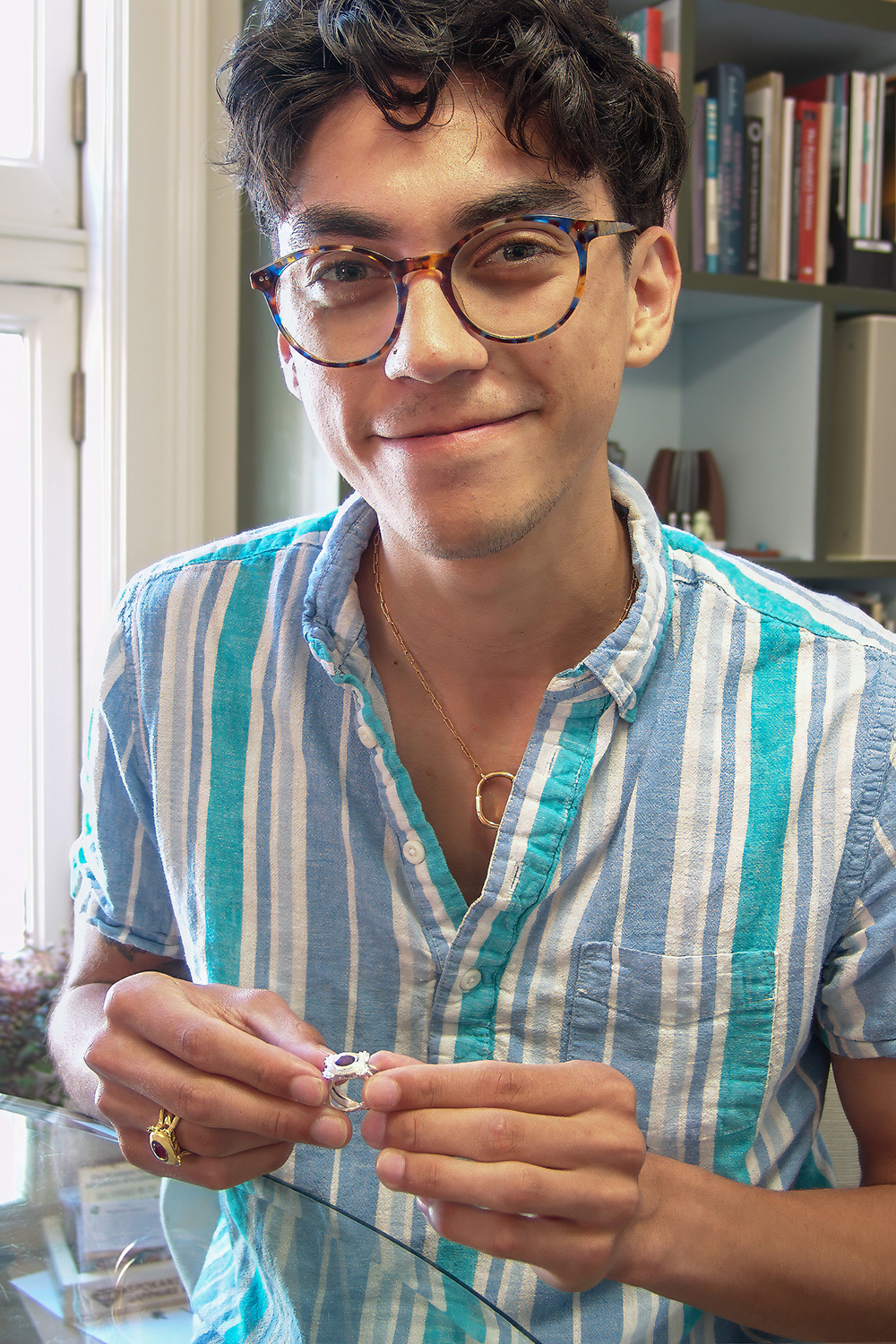When David Durand set out to design his own class ring, he didn’t just want a piece of jewelry – he aimed to distill the essence of his Stanford journey into a wearable creation that tells a story as unique as his own.
The ring, which Durand, a senior product design major, designed and produced as part of an independent study, incorporates university landmarks that are personal to his own Stanford experience. The ring references the twisted Corinthian column of Xu Zhen’s Hello sculpture on Meyer Green, which he and his friends jokingly call “the Churro.” It also includes the iconic entrance point of Palm Drive, the three arches of Memorial Church, and the Oval.

Durand’s ring features references to Stanford landmarks, including the Hello sculpture and the Oval, that are personal to his university experience. | David Durand
Amanda Knox Sather (BA Art History ’98, MA Religious Studies ’99, MFA Design ’03), a lecturer in the Stanford Product Realization Lab, admires the way Durand’s ring uses the landscape of the finger to present Stanford landmarks in a refined way.
“The late Stanford design professor Matt Kahn said, ‘It’s a ring, not an essay,’ and I really love that idea, because you don’t need to know anything about that ring,” said Sather. “You can look at it and see that it has the visual cues of a class ring, and it holds enough content without words that it doesn’t really need to explain itself. I think it’s a delight for anyone with a connection to Stanford to search out all the little references, but it’s abstracted enough that it’s just kind of a cool ring.”
Durand produced two variations of his final design, one cast in silver with a garnet and one cast in gold with a lab-grown ruby. While he considered producing a ring for everyone in the capstone class, right now he’s just happy to have his own unique class ring.

Senior product design major David Durand wearing the gold and silver class rings that he designed and crafted. | Amanda Knox Sather
Durand grew up attending the internationally known annual gem show in his hometown of Tucson, Arizona. When a professor noticed his bracelet in an introductory sketching class and suggested he take a jewelry design class, Durand was intrigued.
“I really liked jewelry, and I’m the biggest fan of Tiffany’s,” he said. “But I never thought there’d be a way to access it. So once I learned that there was a way to get to this new world, I didn’t want to give that up. Like, when else am I going to have the time to actually learn how to silversmith or design jewelry?”
Durand applied to a course in jewelry design (ME 298), offered yearly in the Department of Mechanical Engineering by Sather and Sara Shaughnessy, who also co-own a custom jewelry business.
The course is so popular that he didn’t get in the first time he applied. However, Sather and Shaughnessy were so impressed by Durand’s application essay that they invited him to participate in a pilot program for a class in silver pendant making. After completing the pilot program, Durand took the jewelry design course and two independent studies.
Some may find it surprising that a jewelry design course is housed under mechanical engineering instead of, say, art. But as Sather points out, materials and manufacturing processes are as important as aesthetics in jewelry design: material properties, density, wear characteristics, and more.
“I think many engineers are drawn to the way jewelry design draws on state of the art and ancient techniques,” Sather said. “You have things like laser welding and improved casting methods informed by research, along with things that have worked really well for a few thousand years, like filing and certain kinds of casting. And so it’s a really wonderful intersection.”
With Sather and Shaughnessy’s guidance, David was able to build on what he’d learned about jewelry creation in his previous classes. He applied all the processes of good design, including iteration and brainstorming, and incorporated his ideas into a CAD, or computer-aided design, model that served as the basis for the ring.
It’s a delight for anyone with a connection to Stanford to search out all the little references, but it’s abstracted enough that it’s just kind of a cool ring.”Amanda Knox SatherLecturer, Product Realization Lab
The ring design process significantly improved Durand’s engineering skills.
“I’d show Sara the janky way I did something, and she’d say, ‘No, do it this way.’ And I wouldn’t even have known that was an option,” he said. “So there’s a lot of problem solving and learning how to do CAD. Last quarter is when I was finally like, ‘Oh, I have the skills to really do this design.’”
Durand’s dream is to work for Tiffany & Co. But he also recognizes that what he’s learned in the process of jewelry design from Sather and Shaughnessy might lead him down other paths.
“I think that’s what they’ve been setting me up to do – getting me the skills so that I can work anywhere,” he said. “They tell me there’s value in doing my own thing, and that I have the option to really make a name for myself.”
Durand’s ring, along with other design work, can be found on his online design portfolio.